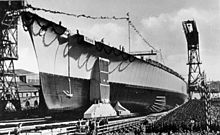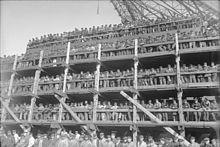Kriegsmarine shipyard Wilhelmshaven
The Kriegsmarinewerft Wilhelmshaven (KMW) in Wilhelmshaven was the most important naval shipyard in the time of the German Empire until 1945 .
It was created after the end of the First World War from the Kaiserliche Werft Wilhelmshaven and was called the Reichsmarinewerft until 1935 . It then passed into the possession of the Kriegsmarine and was primarily concerned with the repair, conversion and maintenance of warships. As a rule, new buildings were only accepted as “filling orders” in order to maintain the high level of personnel, knowledge and machines.
Since 1957 there is on the site of the former shipyard, a naval arsenal for the German Navy and German Navy .
history
The end of the First World War also ended the activities of the Kaiserliche Werft Wilhelmshaven after the last fleet units had been withdrawn at the end of 1918.
The Treaty of Versailles forbade Germany to build warships. The shipyard's capacity has been reduced. Among other things, locomotives were repaired and civil shipbuilding orders were accepted to bridge the gap. Fish steamers and fishing trawlers were built for the newly founded deep-sea fishery in Wilhelmshaven , and several freight and passenger steamers for a shipping company. From 1919 the scrapping business flourished. By 1923 almost 300 warships and merchant ships (from Germany and abroad) had been scrapped.
A part of the shipyard (the so-called Uto shipyard) was called Industriewerke Rüstringen at this time and belonged to the German works . On January 1, 1921, the provisional Reichsmarine became the Reichsmarine ; the shipyard was later called the Reichsmarinewerft .
The first new building of a warship was the light cruiser Emden, built from 1921 to 1925 . The last large ship of the KMW was the battleship Tirpitz , built from 1936 to 1941 .
After the seizure of power by the National Socialists (1933), the Nazi regime began an upgrade to prepare for war; and the Navy has been upgraded . In 1935 the Reichsmarine was renamed the Kriegsmarine (and the Reichswehr the Wehrmacht ); In 1935 the shipyard was also renamed the Wilhelmshaven Navy Shipyard .
In the years that followed, the shipyard facilities were again expanded extensively. The new north shipyard was built with additional docks, port facilities and the associated locks. The so-called Z-Plan for arming the navy had a major impact on the expansion of the shipyard, but it was never implemented.
With the start of the war in 1939, the shipyard's activities shifted. The construction of capital ships that had already started or were planned was discontinued, activities were subsequently limited to the construction of smaller war vehicles and submarines as well as to repair work and the removal of combat damage to ships.
As a major production facility for the defense industry, the shipyard was bombed over a hundred times by British or American air forces , causing numerous damage. The shipyard remained in operation. Many civilians died in the air raids.
At the beginning of 1945 around 17,000 people were working at the shipyard, including around 2,000 prisoners from the Wilhelmshaven concentration camp and the Gestapo prison camp Schwarzer Weg as forced laborers .
On May 6, 1945, Canadian and Polish forces moved into the city of Wilhelmshaven.
The shipyard became the assembly point for ships that had to be repaired and then delivered to one of the victorious powers. The dismantling of the shipyard began in mid-1946, followed by its destruction. Approx. 95% of the buildings were blown up and demolished. A large part of the port area was also completely destroyed, and the port basin and access roads were filled in. The shipyard had practically ceased to exist.
Usage today
From 1957 onwards, numerous new buildings were built on the site of the former Kriegsmarine shipyard over a period of around 15 years, which are still used today as the naval arsenal of the German Navy. As in the past, the main task is the maintenance and repair of marine vehicles.
In 1978 about 6,000 people were employed there.
Of the former shipyard, only the main gate (Gate 1), the now modified shipbuilding hall and parts of the former shipyard fire brigade remain. The shipyard's largest exhibit that still exists is the "Langer Heinrich" floating crane, which is now stationed in Genoa .
Ships of the Reichs- und Kriegsmarinewerft Wilhelmshaven
(Selection; the years given refer to the commissioning of the ships)
- 1920 to 1923, building No. 70 to 99, building of a total of 28 fish steamers of 50 tons each
- 1922, construction no. 66 to 69, construction of the freight and passenger steamers Emil Kirdorf , Carl Legien , Albert Vögler and Adolf v. Bayer for Hugo Stinnes AG
- 1925, building No. 100, light cruiser Emden , first new building of the Reichsmarine after the First World War, badly damaged by British bombs in the shipyard in Kiel in April 1945 , blown up in Heikendorfer Bay in May 1945 and scrapped there until 1948
- 1924, building no. 101, conversion of a gunboat into the survey ship Meteor , awarded to the USSR in 1945 and put into service there as an Ekvator
- 1925 to 1927, building no. 102–107, torpedo boat Möwe and five other boats of the bird of prey class
- 1929, building no.108, light cruiser Königsberg , type ship of the K-Kreuzer ( Königsberg class) , capsized in April 1940 after a British air raid in the port of Bergen, lifted in July 1942 and used as a pier for submarines, capsized again in September 1944, scrapped in Bergen after the end of the war
- 1928 to 1929, building no. 109–114, torpedo boat Wolf and five other boats of the predator class
- 1928, building no.115, Schillig pilot ship
- 1930, building no.116, light cruiser Cologne , sunk by bombs during repair work in the KM shipyard in 1945, scrapped in 1946
- 1931, building no.117, light cruiser Leipzig , loaded with gas ammunition, sunk in front of the Skagerrak in 1946
- 1931, Building No. 118, artillery training ship Bremse , sunk by British cruisers near the North Cape in 1941
- 1931, building no.119, fishing protection ship Elbe , from 1939 escort ship for mine clearance boats, from 1945 with the German Minesweeping Administration , handed over to the Soviet Union in the same year and there as Terek in service, broken up in 1962
- 1931, building no.120, fishing protection ship Weser , from 1939 escort ship for mine clearance boats, from 1945 at the German Minesweeping Administration , broken up in 1954
- 1932, building no.121, Krabbe pilot transfer boat
- 1932, Bau Nr. 122, fuel oil tanker Norderney , marine-owned, 1945 GM / SA, sold 1947, abandoned in 1968
- 1934, building no. 123, armored ship Admiral Scheer , capsized in the construction port of Deutsche Werke Kiel by several bombs in April 1945, wreck partially demolished on site
- 1936, building no. 124, ironclad Admiral Graf Spee , sunk in 1939 in the mouth of the Río de la Plata after a battle with British cruisers
- 1939, Building No. 125, battleship Scharnhorst , sunk by British warships off the North Cape in December 1943
- 1937, building no.126, 127, fleet companion F 9 and F 10
- 1941, building no. 128, battleship Tirpitz , capsized off Tromsø (Norway) in November 1944 by British Tallboy bombs , scrapped on site in the 1950s
- 1941 to 1944, a total of 27 type VII C submarines : U 751 to U 768 and U 771 to U 779 , other boats were already destroyed during construction or construction was canceled
literature
- Gerhard Koop, Kurt Galle, Fritz Klein: From the Imperial Shipyard to the Naval Arsenal . Bernard & Graefe Verlag, Munich 1982, ISBN 3-7637-5252-8



